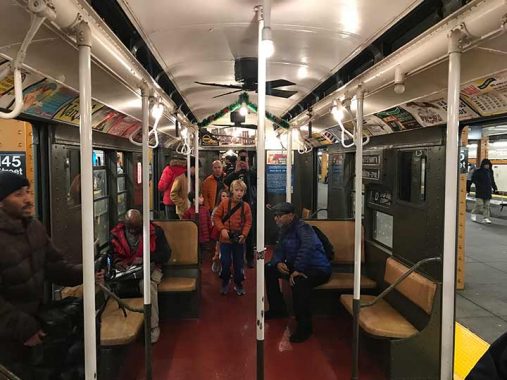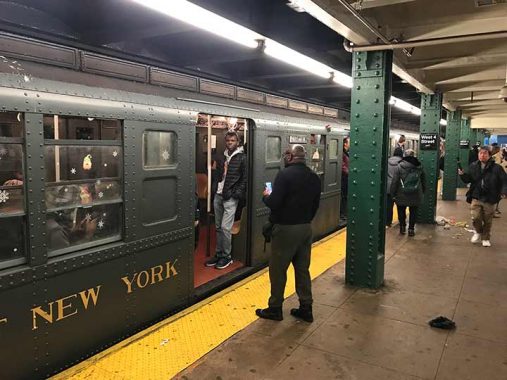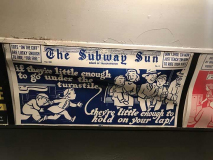
Title card photo by Peter Dougherty, whose Tracks of the NYC Subway’s new edition is available.
THIS weekend is particularly busy with holiday stuff and freelance work, so I’ll do a short piece on the MTA’s holiday train, my first foray in quite awhile. The pandemic ceased the runs for a couple of years. Who knows if the annual Panorama Challenge at the Queens Museum (my team won the first year) or Transit Trivia at the Transit Museum (my team won first prize once and generally is in the money) will ever return.
The Holiday run features a trainset including R1 cars, first used on the original IND line, the 8th Avenue, in 1932, and R9 cars built in 1940 (train buffs call them “Arnines”). The “R” nomenclature, now used for all NYC subway cars, was first developed for the IND, with the “R” standing for Revenue. In 2023, the route was between 2nd Avenue and 145th Street. Today, no line has those two stops in common, but they are most often used by the IND B, D, F and M trains and the cars are holding true to their original IND trackages.
The R1s and R9s generally have the same proportions and seat arrangements; I won’t get into specifics, since I find all that boring and I suspect everyone else but the hardcore “foamers” do, too. Though all began with rattan wicker seating, some were later fitted with red vinyl (in later years, all gained plastic seating due to vandalism; the cars were lit with bare incandescent bulbs, that later had plastic covers; “straps” were white porcelain (as were vertical handholding bars); and overhead fans (with some futility) attempted to keep the cars cool in summer.
Unlike Chicago’s holiday trains, the MTA’s holiday cars are not totally festooned and bedecked with neon Christmas decorations, but there are some modest wreathing and holiday-themed stickers on the windows. This year, the MTA has limited the runs to the five Saturdays in December, and in the first week already had to end things early because of vandalism. There are people whose only enjoyment in the world comes from disruption and destruction; ask them why and blank stares will be your answer.
In 2023, December had little to no cold temperatures or snow…in what is becoming a regular occurrence… so the Holiday Train helps kindle whatever Christmas spirit remains for me after 66-plus years and counting.

One of the cars from 1940. At this point the construction was getting a bit more streamlined, but the seats still had exposed bolts and rattan seats.
I gravitated to the R-1s, with their exposed bolts on the walls, ceiling fans (in use during a warm December), exposed incandescent bulbs and porcelain handholds. I am unsure when the red cushions were first used, likely after the rattan seating became, well, ratty. The local youth made quick work of the red cushions by applying shivs; in newer cars the Transit Authority (today’s MTA) gave up and instituted plastic seats.
I chose to sit in the classic IND R-1 cars complete with original wicker seating, olive paint scheme etc. Believe it or not cars very similar to this were running on the Canarsie Line (L trains) as late as 1977. [In Comments, please indicate which cars those were] In more recent times, the Williamsburg-Jamaica el (J train) was the “museum line” with R32s and 42s, built in the 1960s, well past their retirements on other lines. Today Staten Island Railway runs rehabbed R-44s that are due to be gradually replaced the next few years.

Closeup of the porcelain handholds and exposed incandescent bulb. According to legend they are threaded in reverse so stealing them leaves you with a useless lightbulb.
Amelia Opdyke Jones was a cartoonist who drew a slew of subway posters that gently and humorously called attention to the shortcomings of subway riders in the manners department. The posters were given a faux newspaper masthead called The Subway Sun.
The Sun was introduced originally to warm riders to a fare increase, but the signs evolved to tout technological improvements, highlight travel destinations: ”You too can reach the beach by subway!”-and most memorably, to promote straphanger etiquette. The most famous campaign used Monopoly-like cartoon characters, the women often modeled after Oppy herself, to push good manners on a captive audience. Some considered it propaganda, but at least it was entertaining, and it gave the impression that management was paying attention. ABC News
What Oppy would think about today’s subway etiquette is ripe for speculation.

A look down the corridor of an R-1. Manufacturing subway cars that looked like this in 2023 would likely be prohibitively expensive.

That’s all for me for another year, but the “Holiday Train” will be running again Saturday December 23rd and 30th, 2023.
As always, “comment…as you see fit.” I earn a small payment when you click on any ad on the site. Take a look at the new JOBS link in the red toolbar at the top of the page on the desktop version, as I also get a small payment when you view a job via that link.
12/17/23













23 comments
I remember riding on cars like this in the late 60’s and early 70’s, Brooklyn GG possibly.
I liked Julio and Marisol.
https://en.wikipedia.org/wiki/Julio_and_Marisol
Staten Island rapid transit cars until 1971.
Not these cars. Only ran on NYC subway IND and BMT. Staten Island Rapid cars before the R44s were the same size and dimensions of the BMT standard car, 67 feet long. To an untrained eye the R1-9s look similar, but definitely are different.
Did they let people go from car to car while underway as in days of yore?
The artist Reginald Marsh had a column in Da News called “Subway Sunbeams” with a little sketch
of scenes in the subway
Yes, they did. People went from car to car (and back again).
A few additional comments and thoughts, if I may. I did a full round trip on Dec. 9; I rode briefly on Dec. 16.
The cars in the holiday train consist are various models in the R1(100-399), R4 (400-899), R6(900-1399), R7 (1400-1649) , and R9 (1650-1802) car classes, built between 1930 and 1940. Numbers in parentheses are the car’s fleet numbers, still visible on the holiday train today. This information is from http://www.nycsubway.org, specifically this page:
https://www.nycsubway.org/wiki/The_Independent_Fleet_(1932-1939)
The 1703 cars in this group were all completely interchangeable, so a typical train might have cars in all five classes.
You are correct that “cars very similar to this were running on the Canarsie Line (L trains) as late as 1977.” Both the Canarsie and Broadway-Jamaica (J) trains used R7s and R9s from the late 1960s until the last ones ran in 1976-77. The J and L were the last hurrah for the R1-9 series.
Originally, 1932-1967, these cars ran on the A through GG routes only, until the 1967 Chrystie Street opening that united the BMT and IND divisions. After 1968 they appeared regularly on BMT routes such as the J and L. At that time the D became a hybrid IND-BMT routes so the R1-9s continued to cover some D train assignments.
The R1 cars introduced a standard car body dimension still used today on B Division (lettered) route trains – 60 feet long and 10 feet wide, with four doors per car side. A full length ten car train is thus 600 feet long with forty door openings per side. Should be noted that the earliest R1 cars actually were used on the BMT Sea Beach (today’s N) in regular train service in 1931, to test the cars before full acceptance.
In the 1970s and 1980s the MTA ordered three groups of 75 foot cars – the R44, R46, and R68 class. The R44s still remain today only on the Staten Island Railway, while the R46 and R68 cars still ply lettered (B division) subway lines. The 75 foot design was ultimately not successful because a full length train has eight cars (75 x 8 = 600 feet), reducing total train door openings to 32. Beginning with the R143 cars about twenty years ago, MTA went back to the original 1930 car dimensions, a tried and true design.
The new R211 cars have just joined the fleet, and by coincidence I rode one Dec. 16 right after riding the nostalgia train. Thus, I witnessed 90 years of subway designs in ten minutes. They will replace all of the R44s on the Staten Island route, and ultimately all of the R46s.
Finally, I will have some additional comments in a day or so, in a separate posting about The Subway Sun. I took liked the cartoons and photos that were displayed.
Once upon time, there was a subway route that had stops at 145th Street and Second Avenue. It was the D, when it operated on the Culver line in Brooklyn. Coney Island bound, after Broadway-Lafayette, it traveled on today’s F route, stopping at Second Avenue. along its way to Coney Island.
I remember this from riding from riding R1s from 155th Street-8th Ave., all the way to Coney Island with my aunt in the early 60s.
This event, like the City Hall station visit, went from a sparsely attended little known event to a wildly popular scene, with the City Hall visit selling out minutes into the members only sale. The Holiday Train used to begin in Queens Plaza and seats were plentiful.
Yes Ron S, the annual holiday train runs are wildly successful.
For only one train fare, you can experience all Kevin writes about. It’s like going back to a very different and beautifully designed time capsule in which if you didn’t have a newspaper or book, the ads kept you going. Happy to report that these holiday runs are loved by nostalgia fashionistas, dancers, singers, swing bans, photographers…in addition to railfans of all ages. The crowds are friendly, entertaining and just delighted to be there!!!
Some Subway Sun posters used a feline named Etti-Cat to convey messages about passenger manners on trains. The black and white cat gave his/her approval or disapproval to specific behaviors onboard trains. It was a cute and clever way to get the message across, using a furry friend. Idea was for riders to “pawse” and read the poster and then follow the feline’s guidance for a more “purrfect” underground experience.
Sorry – I can’t resist a bad pun.
They should have had the motorman dressed up as Santa
I would see these on the QB or QJ occasionally in the 70’s
I haven’t ridden on the NYC subway since the late-60’s, but the photo’s are exactly what I remember. And the lightbulbs WERE reverse threaded!
Only the emergency light bulbs near the doors were reverse threaded, because they were normally cool since they only went on crossing third rail gaps. The normal illumination bulbs were normally threaded because the heat from the bulbs would thwart any bulb snatchers.
Heavy gloves?
There’s a great chase scene using these R7-R9 subway cars in the 1981 Sylvester Stallone thriller “Nighthawks.” These cars were already out of service by ’81, but I guess the producers needed to rent some clean, graffiti-free subway cars for the chase scene and they went to the Transit Museum folks. Good movie, BTW.
Hey Andy,
Weren’t the incandescent bulbs used in the stairways and stations reverse threaded? Just wondering, because when I first came to NY, I seem to remember trying unscrew a bulb at the 116 Street IND station and it didn’t unscrew the regular way.
omg, those awful wicker seats! Back in the 60s and 70s when women wore dresses only (no pants) to the office, our commute was too often plagued by torn stockings or pantyhose on the way to or from work. And the worn/torn wicker was often just below the seat edge, so you couldn’t see it, but would rip your nylons as soon as you sat down and placed your legs against the seat. I remember standing from South Ferry all the way to midtown even where there were seats available just to avoid that.
Those straw seats were unbearably sticky in the summer, and those ceiling fans did absolutely nothing! I still remember riding these trains when I was a little girl.
The lamps used in subway cars were usually 30 volt street railway bulbs. Twenty to twenty-two lamps were operated in series( like the old Xmas tree light strings) on the six hundred volts supplied by the third rail. The bulb had an internal cut out. Should a bulb burn out, it would automatically close the the circuit to keep the other lamps burning. The sockets also had an internal contact that would maintain the circuit if a bulb was unscrewed. If someone stole a bulb thinking it would work on a household circuit they would be surprised. First when screwed into a 120 volt socket, the 30 volt bulb would burn out immediately, then when the cutout feature activated, it would blow out the fuse or circuit breaker. The person probably wouldn’t steal any more of the subway car bulbs.
Platforms, stairs and tunnels were usually lit by 36 and 56 watt, 130 volt street railway bulbs, operating five in series on the 600 volt third rail supply. Since there could not be a cut out device for this type of bulb, if one burned out, all five were out. There was a discussion in the electrical department that I worked in between an electrician and the foreman. The electrician said that transit used left hand thread bulbs. The foreman said he had been a NYC Transit lighting maintainer for over fifteen years, changed tens of thousands of bulbs on the BMT,IRT, and IND, and had never changed anything other than right hand thread bulbs.
That bulb may have been difficult to remove because of the special sockets used by Transit. The sockets have a very strong spring that bears against the threaded portion of the lamp base. This is to prevent loosening by the extreme vibration these bulbs are subject to.
I did this in Dec 2019, and had planned for a 2020 return, but Covid got in the way. Maybe 2024 will be my year.